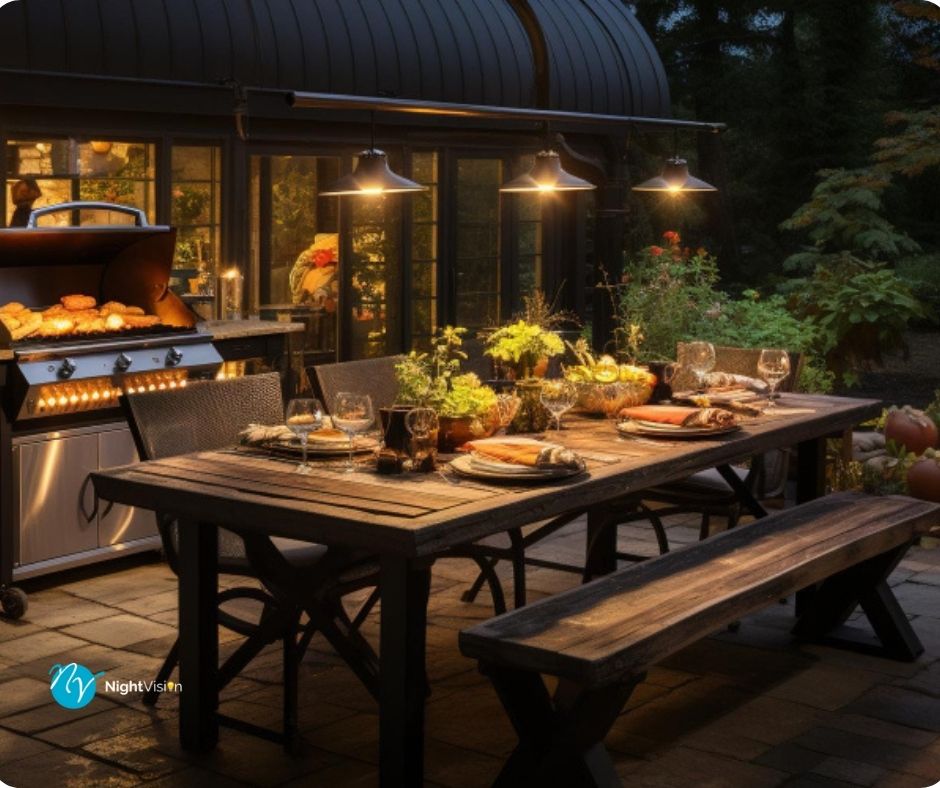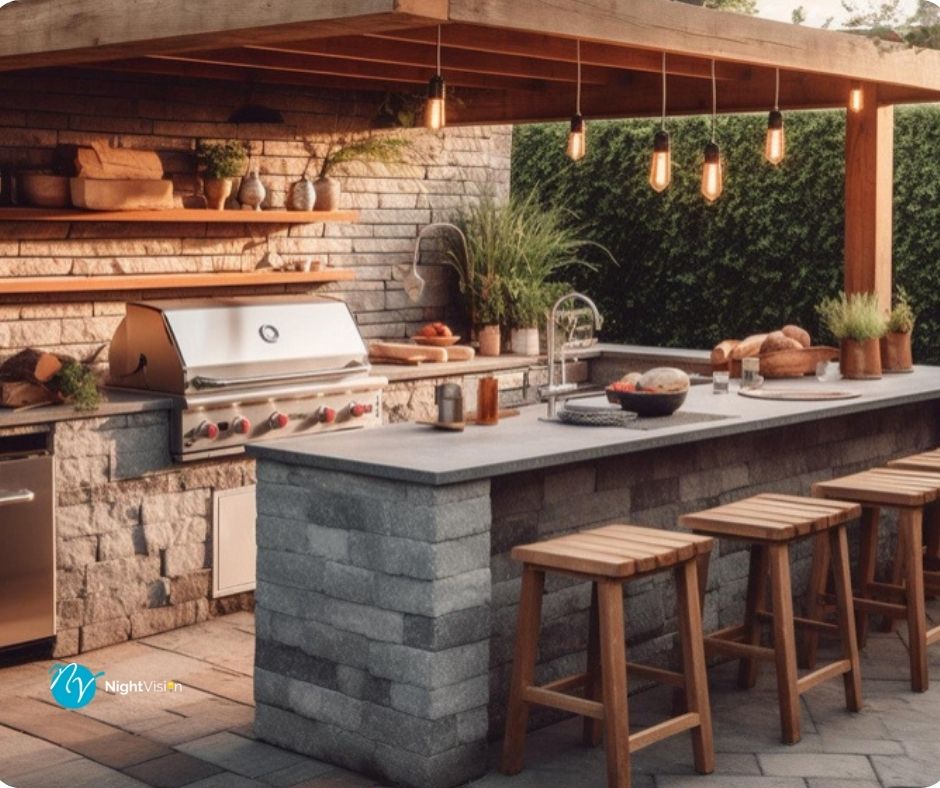Outdoor kitchens have become a popular feature in modern homes, offering a unique blend of culinary convenience and outdoor entertainment.
While the design and functionality of outdoor kitchens often take center stage, one crucial aspect that is sometimes overlooked is lighting.
In this comprehensive guide, we delve into the art and science of outdoor kitchen lighting mastery, exploring everything from fixture selection to placement strategies and innovative technologies.
Introduction to Outdoor Kitchen Lighting
Outdoor kitchen lighting serves a dual purpose: it enhances both the ambiance and functionality of outdoor culinary spaces.
Whether you’re grilling under the stars or hosting a dinner party in your backyard, the right lighting can elevate the experience to new heights.
But what exactly makes outdoor kitchen lighting so essential?
Importance of lighting in outdoor kitchens: Proper lighting ensures that you can safely navigate your outdoor cooking and dining areas, regardless of the time of day or night.
It also creates a welcoming atmosphere for guests, encouraging social interaction and relaxation.
Enhancing ambiance and functionality: From accentuating architectural features to illuminating cooking surfaces, outdoor kitchen lighting plays a crucial role in creating a visually appealing and efficient outdoor workspace.
Overview of key factors to consider: Before diving into the specifics of outdoor kitchen lighting, it’s essential to understand the various types of lighting available and how they can be integrated into your outdoor living space.
Types of Outdoor Kitchen Lighting

When planning your outdoor kitchen lighting scheme, it’s essential to consider the different types of lighting and their respective roles in creating a well-lit and inviting outdoor environment.
Task lighting: Task lighting focuses on providing bright, concentrated light to specific work areas such as grill stations, countertops, and sinks.
This type of lighting is essential for ensuring safety and efficiency during food preparation and cooking.
Ambient lighting: Ambient lighting sets the overall mood and atmosphere of your outdoor kitchen, providing general illumination throughout the space.
This can include overhead fixtures, wall sconces, and lanterns that cast a warm, inviting glow.
Accent lighting: Accent lighting is used to highlight architectural features, landscaping elements, and decorative elements within your outdoor kitchen area.
This can include spotlights, uplights, and LED strip lighting that adds depth and visual interest to your outdoor space.
Decorative lighting: Decorative lighting adds a touch of style and personality to your outdoor kitchen, serving as both functional and aesthetic elements.
This can include pendant lights, chandeliers, and string lights that create a festive ambiance for outdoor entertaining.
Choosing the Right Lighting Fixtures
Selecting the appropriate lighting fixtures for your outdoor kitchen is crucial to achieving both practical illumination and aesthetic appeal.
Consider the following factors when choosing lighting fixtures:
LED vs. traditional lighting: LED lighting has become increasingly popular for outdoor applications due to its energy efficiency, longevity, and versatility.
LED fixtures come in a variety of styles and colors, making them ideal for customizing your outdoor lighting design.
Weather-resistant materials: Outdoor lighting fixtures must be constructed from durable, weather-resistant materials that can withstand exposure to the elements.
Look for fixtures made from corrosion-resistant metals such as stainless steel or aluminum, as well as UV-resistant plastics and glass.
Energy efficiency considerations: Opt for energy-efficient lighting options such as LED fixtures and solar-powered lights to minimize energy consumption and reduce your carbon footprint.
Not only are these options environmentally friendly, but they can also save you money on your energy bills in the long run.
Placement and Layout of Lighting Fixtures
The strategic placement of lighting fixtures is key to achieving optimal illumination and visual impact in your outdoor kitchen space.
Consider the following tips when planning the layout of your outdoor lighting:
Strategic positioning for optimal illumination: Place task lighting fixtures such as under-cabinet lights and pendant lights directly above key work areas to minimize shadows and glare.
For ambient lighting, distribute fixtures evenly throughout the space to ensure uniform illumination.
Highlighting key areas: Identify focal points within your outdoor kitchen, such as cooking stations, dining areas, and pathways, and use lighting to highlight these areas.
This can help create visual interest and guide the flow of traffic within your outdoor space.
Avoiding glare and shadows: Position lighting fixtures at an appropriate height and angle to minimize glare and shadows.
Consider installing dimmer switches or adjustable fixtures that allow you to control the intensity and direction of the light as needed.
Safety Considerations
When designing and installing outdoor kitchen lighting, safety should be a top priority to prevent accidents and ensure the longevity of your lighting fixtures.
Waterproofing and durability: Choose lighting fixtures that are specifically designed for outdoor use and are rated for wet or damp locations.
Look for fixtures with IP (Ingress Protection) ratings indicating their resistance to moisture, dust, and debris.
Proper waterproofing and sealing of electrical connections are essential to prevent corrosion and electrical hazards.
Electrical wiring safety: Ensure that all electrical wiring and connections are installed according to local building codes and regulations.
Use outdoor-rated wiring and junction boxes, and consider hiring a licensed electrician to handle any electrical work to ensure safety and compliance.
Compliance with local building codes: Familiarize yourself with local building codes and regulations governing outdoor lighting installation, including setback requirements, maximum wattage limits, and restrictions on light pollution.
Failure to comply with these regulations can result in fines or penalties and may compromise the safety and functionality of your outdoor kitchen lighting system.
Seasonal Adjustments and Maintenance
To keep your outdoor kitchen lighting system operating smoothly and efficiently year-round, it’s essential to perform regular maintenance and make seasonal adjustments as needed.
Winterizing outdoor lighting fixtures: In colder climates, take precautions to protect outdoor lighting fixtures from freezing temperatures, snow, and ice.
Remove or cover fixtures that are susceptible to damage from winter weather, and consider installing heating elements or insulating covers to prevent frost and condensation buildup.
Cleaning and upkeep for longevity: Regularly clean outdoor lighting fixtures to remove dirt, debris, and insect buildup that can obstruct light output and cause corrosion.
Use a mild detergent and water solution to clean fixtures and lenses, and avoid harsh chemicals or abrasive cleaning tools that may damage finishes or coatings.
Replacing bulbs and troubleshooting common issues: Keep spare bulbs on hand for quick replacement when needed, and periodically check for burned-out bulbs or flickering lights. Inspect wiring connections for signs of wear or damage, and promptly address any issues to prevent electrical problems or malfunctions.
Innovative Lighting Technologies
Advancements in lighting technology have revolutionized outdoor kitchen design, offering a wide range of innovative features and capabilities to enhance both aesthetics and functionality.
Smart lighting systems: Smart lighting systems allow you to control your outdoor kitchen lighting remotely via smartphone, tablet, or voice command using integrated smart home platforms such as Amazon Alexa or Google Assistant.
This provides flexibility and convenience in adjusting lighting settings, scheduling timers, and creating custom lighting scenes.
Color-changing LED options: LED lighting fixtures with color-changing capabilities allow you to customize the ambiance of your outdoor kitchen with a spectrum of hues and tones.
Whether you’re hosting a festive outdoor gathering or seeking to create a tranquil atmosphere for relaxation, color-changing LEDs offer endless possibilities for creative expression.
Motion sensor activation for convenience and security: Motion-activated lighting fixtures automatically illuminate in response to movement, providing added convenience and security for outdoor spaces.
These fixtures are ideal for pathways, entryways, and dark corners where extra illumination may be needed, and can help deter intruders and wildlife.
Conclusion
In conclusion, mastering outdoor kitchen lighting is not merely about enhancing the visual appeal of your culinary space; it’s about elevating the entire outdoor dining and entertaining experience.
By understanding the importance of different types of lighting, selecting the right fixtures, strategically placing them, prioritizing safety, and embracing innovative technologies, you can create a welcoming and functional outdoor kitchen that shines both day and night.
Whether you’re grilling, dining, or simply enjoying the ambiance, proper outdoor kitchen lighting ensures that every moment spent in your outdoor oasis is illuminated with culinary brilliance.
Ready to transform your outdoor kitchen? Contact us at NightVision Outdoor Lighting for expert guidance and assistance.
FAQs
Why is outdoor kitchen lighting important?
Outdoor kitchen lighting is essential for both safety and ambiance. It ensures that you can navigate your outdoor cooking and dining areas safely, regardless of the time of day or night, while also creating a welcoming atmosphere for guests.
What types of outdoor kitchen lighting are available?
There are several types of outdoor kitchen lighting, including task lighting, ambient lighting, accent lighting, and decorative lighting. Each serves a specific purpose in enhancing the functionality and aesthetics of your outdoor space.
How do I choose the right lighting fixtures for my outdoor kitchen?
When selecting lighting fixtures, consider factors such as LED vs. traditional lighting, weather-resistant materials, and energy efficiency. Choose fixtures that not only provide practical illumination but also complement the design of your outdoor kitchen.
What safety considerations should I keep in mind when installing outdoor kitchen lighting?
Safety should be a top priority when designing and installing outdoor kitchen lighting. Ensure that fixtures are waterproof and durable, electrical wiring is installed according to local building codes, and all safety regulations are followed to prevent accidents and ensure longevity.
How can I maintain my outdoor kitchen lighting system year-round?
To keep your outdoor kitchen lighting system operating smoothly, perform regular maintenance tasks such as winterizing fixtures, cleaning regularly, and replacing bulbs as needed. Additionally, troubleshoot any common issues promptly to prevent electrical problems or malfunctions.



